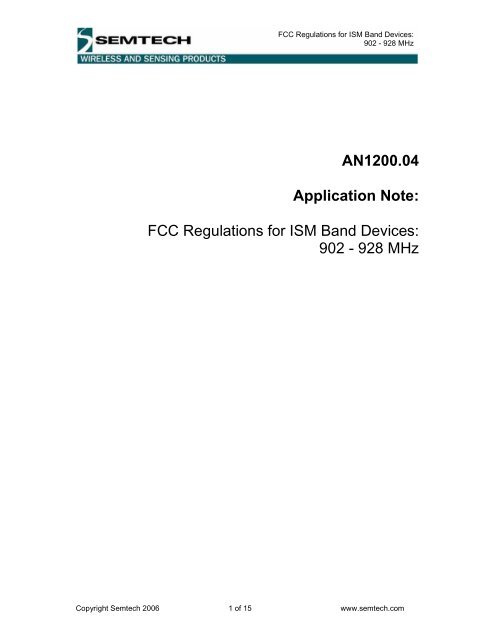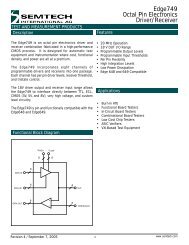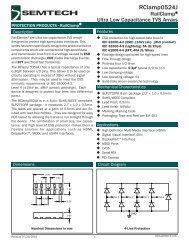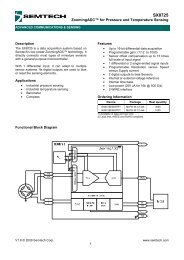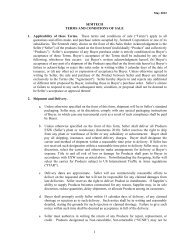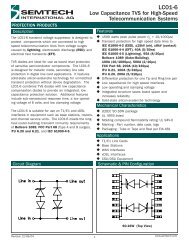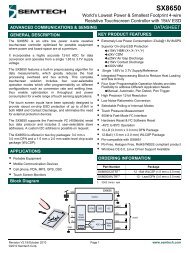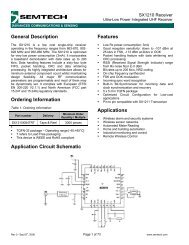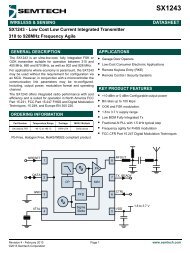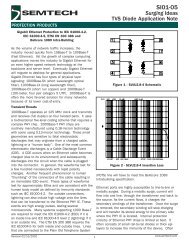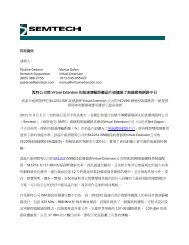FCC Regulations for ISM Band Devices - Semtech
FCC Regulations for ISM Band Devices - Semtech
FCC Regulations for ISM Band Devices - Semtech
Create successful ePaper yourself
Turn your PDF publications into a flip-book with our unique Google optimized e-Paper software.
<strong>FCC</strong> <strong>Regulations</strong> <strong>for</strong> <strong>ISM</strong> <strong>Band</strong> <strong>Devices</strong>:<br />
902 - 928 MHz<br />
1 Table of Contents<br />
1 Table of Contents.............................................................................................................................2<br />
1.1 Index of Figures .....................................................................................................................2<br />
1.2 Index of Tables ......................................................................................................................2<br />
2 Introduction ......................................................................................................................................3<br />
3 An Overview of <strong>FCC</strong> <strong>Regulations</strong> ....................................................................................................3<br />
3.1 <strong>FCC</strong> Part 15...........................................................................................................................3<br />
3.2 Part 15.247 ............................................................................................................................3<br />
3.2.1 Frequency Hopping Spread Spectrum Requirements ......................................................3<br />
3.2.2 Digital Modulation Scheme Requirements ........................................................................4<br />
3.3 Part 15.249 ............................................................................................................................5<br />
3.4 Part 15.243 ............................................................................................................................5<br />
3.5 Part 15.245 ............................................................................................................................5<br />
4 Device Measurements .....................................................................................................................6<br />
4.1 Part 15.247 Measurements <strong>for</strong> Frequency Hopping Systems...............................................6<br />
4.1.1 20 dB Channel <strong>Band</strong>width.................................................................................................6<br />
4.1.2 Carrier Frequency Separation ...........................................................................................6<br />
4.1.3 Number of Hopping Channels ...........................................................................................7<br />
4.1.4 Dwell Time.........................................................................................................................7<br />
4.1.5 Peak Output Power ...........................................................................................................7<br />
4.1.6 <strong>Band</strong> Edge Conducted Emissions.....................................................................................7<br />
4.1.7 Spurious RF Conducted Emissions...................................................................................9<br />
4.2 Part 15.247 Measurements <strong>for</strong> Digital Modulation Schemes ................................................9<br />
4.2.1 Signal <strong>Band</strong>width...............................................................................................................9<br />
4.2.2 Output Power.....................................................................................................................9<br />
4.2.3 Spurious RF Conducted Emissions.................................................................................11<br />
4.2.4 Power Spectral Density ...................................................................................................11<br />
4.3 Part 15.209 Measurements .................................................................................................12<br />
4.3.1 Open-Air Test Site Requirements ...................................................................................13<br />
4.3.2 Duty Cycle Correction Factor ..........................................................................................14<br />
5 Conclusions ...................................................................................................................................15<br />
6 Further In<strong>for</strong>mation ........................................................................................................................15<br />
1.1 Index of Figures<br />
Figure 1: FHSS and Digital Modulation Scheme Spectrums ..................................................................4<br />
Figure 2: Measurement of 20 dB <strong>Band</strong>width...........................................................................................6<br />
Figure 3: Measurement of Carrier Frequency Separation ......................................................................7<br />
Figure 4: Measurement of Hopping Channel Dwell Time .......................................................................8<br />
Figure 5: Transient <strong>Band</strong> Edge Conducted Emissions Measurement....................................................8<br />
Figure 6: Measurement of Signal <strong>Band</strong>width..........................................................................................9<br />
Figure 7: Measurement of Peak Spectrum Density ..............................................................................12<br />
Figure 8: 3 Meter Test Site....................................................................................................................14<br />
1.2 Index of Tables<br />
Table 1: Restricted Frequency <strong>Band</strong>s...................................................................................................13<br />
Table 2: Emitted Field Strength Limits ..................................................................................................13<br />
Copyright <strong>Semtech</strong> 2006 2 of 15 www.semtech.com
<strong>FCC</strong> <strong>Regulations</strong> <strong>for</strong> <strong>ISM</strong> <strong>Band</strong> <strong>Devices</strong>:<br />
902 - 928 MHz<br />
2 Introduction<br />
The purpose of this technical note is to assist the engineer in understanding the requirements,<br />
including test methodology, of the Federal Communications Commission (<strong>FCC</strong>) towards operating of<br />
non-licensed devices operating in the 902 - 928 MHz <strong>ISM</strong> band.<br />
It is intended that this report is read in conjunction with the following documents:<br />
• Part 15 of Title 47 of the Code of Federal <strong>Regulations</strong><br />
• <strong>FCC</strong> Office of Engineering and Technology; “Understanding the <strong>FCC</strong> <strong>Regulations</strong> <strong>for</strong> Low-<br />
Power, Non-Licensed Transmitters (OET Bulletin 63); February 1996<br />
• <strong>FCC</strong> Filing and Measurement Guidelines <strong>for</strong> Frequency Hopping Spread Spectrum Systems<br />
(DA 00-705); March 30, 2000<br />
• <strong>FCC</strong> Office of Engineering and Technology; “Measurement of Digital Transmission Systems<br />
Operating under Section 15.247”; March 23, 2005<br />
3 An Overview of <strong>FCC</strong> <strong>Regulations</strong><br />
Low-power, non-licensed devices operating in the 902 - 928 MHz <strong>ISM</strong> band are everywhere, from<br />
simple toys, wireless security systems, wireless telemetry, through to wireless automatic meter<br />
reading.<br />
In the United States, the <strong>FCC</strong> is the body responsible <strong>for</strong> implementing rules to limit the potential <strong>for</strong><br />
interference to licensed operations by low-power, non-licensed transmitters. These rules are<br />
documented in Part 15 of Title 47 of the Code of Federal <strong>Regulations</strong> (“<strong>FCC</strong> Part 15”), and it is<br />
recommended that the engineer refers to an up to date version of this regulation.<br />
3.1 <strong>FCC</strong> Part 15<br />
Operation to <strong>FCC</strong> Part 15 is subject to two conditions. Firstly, the device may not cause harmful<br />
interference, and secondly the device must accept any interference received, including interference<br />
that may cause undesired operation. Hence, there is no guaranteed quality of service when operating<br />
a Part 15 device.<br />
For operation in the 902 - 928 MHz band, a low-power, non-licensed device will generally fall within<br />
the remit of the following subparts of the regulation:<br />
• Part 15.247: Frequency Hopping and Digitally Modulated Intentional Radiators<br />
• Part 15.249: General Non-Licensed Intentional Radiators<br />
Note that other subparts of <strong>FCC</strong> Part 15 can be applied to devices operating in the 900 MHz band<br />
and these are briefly discussed later in this document.<br />
3.2 Part 15.247<br />
<strong>Devices</strong> that operate to <strong>FCC</strong> Part 15.247 are limited to frequency hopping and digitally modulated<br />
schemes. The two processes are illustrated below in Figure 1.<br />
3.2.1 Frequency Hopping Spread Spectrum Requirements<br />
Frequency hopping schemes are often referred to as frequency hopping spread spectrum (FHSS) To<br />
be considered as a compliant <strong>for</strong> a frequency hopping system the device or system must meet the<br />
following requirements:<br />
1. The channel carrier frequencies must be separated by a minimum of 25 kHz, or the 20 dB<br />
bandwidth of the hopping channel, whichever is the greater.<br />
2. The channel hopping frequencies which are selected at the system, hopping rate must be<br />
pseudo-random in nature. On average, each channel hopping frequency must be used<br />
equally.<br />
3. The receiver bandwidth should match that of the transmitter and will hop in synchronization.<br />
Copyright <strong>Semtech</strong> 2006 3 of 15 www.semtech.com
<strong>FCC</strong> <strong>Regulations</strong> <strong>for</strong> <strong>ISM</strong> <strong>Band</strong> <strong>Devices</strong>:<br />
902 - 928 MHz<br />
4. If the 20 dB bandwidth is less than 250 kHz, the system shall use at least 50 channels. The<br />
average dwell time on a particular channel shall not exceed 400 mS within a 20 second<br />
period. If the 20 dB bandwidth is 250 kHz or greater, then the system shall use at least 25<br />
channels. The average dwell time shall not exceed 400 mS within a 10 second period.<br />
5. The maximum allowed 20 dB bandwidth of the hopping channel is 500 kHz.<br />
6. For systems employing at least 50 channels, the maximum peak conducted output power<br />
output is +30 dBm (1 W). For systems employing less than 50 channels but at least 25<br />
channels, the maximum output power is +24 dBm (0.25 W).<br />
7. If the antenna used has a directional gain in excess of 6 dBi then the conducted output power<br />
shall be reduced by the amount in dB that the directional gain of the antenna exceeds 6 dBi.<br />
8. In any 100 kHz bandwidth outside the frequency band of operation the power shall be at least<br />
20 dB below that in the 100 kHz bandwidth within the band that contains the highest level of<br />
the desired power.<br />
9. Radiated harmonic and spurious emissions which fall within the restricted bands, as defined<br />
in <strong>FCC</strong> Part 15.205 must comply with the radiated emission limits specified in <strong>FCC</strong> Part<br />
15.209. Please refer to Sections 4.1.7 and 4.2.3 <strong>for</strong> further details.<br />
From the above it can be seen that in the process of frequency hopping the signal appears to occupy<br />
a very wide bandwidth, although the instantaneous signal bandwidth can is either narrowband or<br />
wideband (providing that the 20 dB signal bandwidth does not exceed 500 kHz).<br />
FHSS<br />
f C1 f C2<br />
f C3 f C4<br />
f C<br />
f C1<br />
f C<br />
Digital<br />
Modulation<br />
Scheme<br />
Figure 1: FHSS and Digital Modulation Scheme Spectrums<br />
3.2.2 Digital Modulation Scheme Requirements<br />
The <strong>FCC</strong>, under the definition of digital modulation schemes, allows a device to comply with these<br />
regulations without necessarily implementing Direct Sequence Spread Spectrum (DSSS), provided<br />
that the following requirements are met:<br />
1. The minimum 6 dB bandwidth of the signal shall be at least 500 kHz.<br />
Copyright <strong>Semtech</strong> 2006 4 of 15 www.semtech.com
<strong>FCC</strong> <strong>Regulations</strong> <strong>for</strong> <strong>ISM</strong> <strong>Band</strong> <strong>Devices</strong>:<br />
902 - 928 MHz<br />
4 Device Measurements<br />
4.1 Part 15.247 Measurements <strong>for</strong> Frequency Hopping Systems<br />
Unless specified, the spectrum analyzer detector should be set to peak; the video bandwidth (VBW)<br />
should be equal or greater than the resolution bandwidth (RBW) of the instrument, and the display set<br />
to peak hold.<br />
4.1.1 20 dB Channel <strong>Band</strong>width<br />
Center the spectrum analyzer about a modulated carrier with data present. Set the frequency span to<br />
approximately twice or three times the 20 dB. Measure the 20 dB channel bandwidth using either the<br />
spectrum analyzer’s delta-marker or reference line function, as illustrated below in Figure 2. Note that<br />
the RBW should be at least 1% of the measured 20 dB bandwidth. The effect on the measured<br />
channel bandwidth as a function of the spectrum analyzer RBW is highlighted. With the RBW set to 3<br />
kHz (approximately 1% of the measured 20 dB bandwidth under these test conditions); the measured<br />
bandwidth is 34.5 kHz. With the RBW set to 10 kHz, the measured bandwidth is 57 kHz.<br />
A <strong>FCC</strong> accredited test lab will be able to advise on the correct measurement configuration.<br />
RBW = 10 kHz<br />
Limit Line<br />
RBW = 3 kHz<br />
20 dB<br />
Figure 2: Measurement of 20 dB <strong>Band</strong>width<br />
4.1.2 Carrier Frequency Separation<br />
The device under test should have frequency hopping enabled. The frequency span of the spectrum<br />
analyzer should be wide enough to capture the peaks of two adjacent channels. Figure 3 below<br />
illustrates the measurement of carrier frequency separation. Since the <strong>FCC</strong> refer to the carrier<br />
frequency separation, this parameter can be measured on either an un-modulated carrier or the<br />
modulated signal (in the case of 2-level FSK the mid point between the peal-to-peak frequency<br />
deviation of the modulated carrier should be used as the reference). The frequency span should be<br />
set wide enough to capture the peaks of two adjacent hopping channels and the resolution bandwidth<br />
set to at least 1% of the span.<br />
Copyright <strong>Semtech</strong> 2006 6 of 15 www.semtech.com
<strong>FCC</strong> <strong>Regulations</strong> <strong>for</strong> <strong>ISM</strong> <strong>Band</strong> <strong>Devices</strong>:<br />
902 - 928 MHz<br />
With reference to the observations of Section 4.1.1, the channel separation, at 100 kHz, complies with<br />
<strong>FCC</strong> requirements. If numerous data rates and frequency deviation settings are applied <strong>for</strong> different<br />
modes of operation, a separate measurement must be made <strong>for</strong> each mode.<br />
Modulation<br />
Disabled<br />
Figure 3: Measurement of Carrier Frequency Separation<br />
4.1.3 Number of Hopping Channels<br />
Set the span of the frequency synthesizer to cover the entire 902 - 928 MHz band, if necessary the<br />
span may be broken up into sections to enable each discrete hopping carrier frequency to be<br />
displayed. The RBW should be at least 1% of the total span.<br />
4.1.4 Dwell Time<br />
With frequency hopping enabled, set the spectrum analyzer to zero span mode centered on a<br />
hopping channel. Adjust the sweep time to capture the entire on-channel dwell period and set the<br />
RBW to 1 MHz. An example of a dwell time measurement is illustrated in Figure 4.<br />
4.1.5 Peak Output Power<br />
To measure the peak output power, center the spectrum analyzer on a hopping channel and set the<br />
span to approximately 5 times the 20 dB bandwidth measured in Section 4.1.1 and the RBW to<br />
greater than the 20 dB bandwidth. Take into account the cable loss associated with the measurement.<br />
4.1.6 <strong>Band</strong> Edge Conducted Emissions<br />
To per<strong>for</strong>m these measurements, select the channels closest to the frequency band edges at 902<br />
MHz and 928 MHz. Set the span to be wide enough to observe the peak level of the emission on the<br />
channel closest to the band edge as well as any modulation products that fall outside the authorized<br />
band of operation. The RBW should be greater than 1% of the span and at least 100 kHz (since the<br />
requirements of the <strong>FCC</strong> are <strong>for</strong> measurement within a 100 kHz bandwidth). Ensure that any<br />
emissions that fall outside the 902 - 928 MHz band are at least 20 dB below the peak amplitude of the<br />
wanted transmission.<br />
Repeat the above procedure, but this time with frequency hopping enabled, to ensure that any<br />
switching transients caused by the hopping function also comply with the specified limits.<br />
Copyright <strong>Semtech</strong> 2006 7 of 15 www.semtech.com
<strong>FCC</strong> <strong>Regulations</strong> <strong>for</strong> <strong>ISM</strong> <strong>Band</strong> <strong>Devices</strong>:<br />
902 - 928 MHz<br />
Figure 4: Measurement of Hopping Channel Dwell Time<br />
An example of a band edge emissions measurement is indicated below in Figure 5. Note that<br />
although there is evidence of switching transients below the band edge of 902 MHz, and the skirt of<br />
the transmitter is clearly visible, that these are below the 20 dB limit of the specification.<br />
20 dB<br />
Figure 5: Transient <strong>Band</strong> Edge Conducted Emissions Measurement<br />
Copyright <strong>Semtech</strong> 2006 8 of 15 www.semtech.com
<strong>FCC</strong> <strong>Regulations</strong> <strong>for</strong> <strong>ISM</strong> <strong>Band</strong> <strong>Devices</strong>:<br />
902 - 928 MHz<br />
4.1.7 Spurious RF Conducted Emissions<br />
Whilst <strong>FCC</strong> require that RF spurious emissions falling within restricted frequency bands as defined in<br />
subpart 15.205 must comply with the limits defined in subpart15.209 are measured in open-field test<br />
conditions, <strong>FCC</strong> Part 15.247 requires that all harmonics and spurs must be at least 20 dB below the<br />
highest emission level within the authorized frequency band, when measured with a 100 kHz RBW.<br />
Typically several measurements will be required to cover the entire band of interest. The RBW should<br />
be set to 100 kHz. VBW should be greater than RBW.<br />
Spurious emissions should be measured from the lowest frequency generated by the device, in-band<br />
emissions as well as spurious and harmonic emissions up to the 10 th harmonic of the channel<br />
frequency. Note that the lowest frequency emission generated by the device can include reference<br />
oscillator, clock signals and any low frequency emissions from the microcontroller.<br />
4.2 Part 15.247 Measurements <strong>for</strong> Digital Modulation Schemes<br />
4.2.1 Signal <strong>Band</strong>width<br />
The signal bandwidth, with modulation enabled, is measured using a spectrum analyzer of frequency<br />
span wide enough to capture the entire modulation envelope and RBW of 100 kHz, as illustrated<br />
below in Figure 6.<br />
6 dB<br />
Figure 6: Measurement of Signal <strong>Band</strong>width<br />
4.2.2 Output Power<br />
There are two methods recommended by the <strong>FCC</strong> <strong>for</strong> measuring the output power of a digitally<br />
transmitted signal under section 15.247. The first method is a peak power measurement, similar to<br />
that described in Section 4.1.5. The frequency span of the spectrum analyzer should be wide enough<br />
to capture the entire modulated signal and the RBW set greater than the 6 dB signal measured in<br />
4.2.1, above.<br />
The second method assumes a pulse transmission, where the transmitter is transmitting at maximum<br />
output power <strong>for</strong> a time period, T.<br />
Copyright <strong>Semtech</strong> 2006 9 of 15 www.semtech.com
<strong>FCC</strong> <strong>Regulations</strong> <strong>for</strong> <strong>ISM</strong> <strong>Band</strong> <strong>Devices</strong>:<br />
902 - 928 MHz<br />
If the sweep time of the spectrum analyzer is < T, then spectral trace averaging and summing the<br />
power across the band can be employed. This procedure should only be employed if it results in<br />
averaging over intervals where the transmitter is operating at maximum output power.<br />
The procedure is listed below:<br />
1. Set the frequency span of the spectrum analyzer to be wide enough to cover the entire<br />
modulated signal.<br />
2. Set RBW to 1 MHz and VBW to at least 3 MHz.<br />
3. If the frequency span/number of points of the display (“bin width”) is < 0.5 RBW then use the<br />
spectrum analyzer’s sample detector. Otherwise select peak detector mode of operation.<br />
4. Select video triggering and ensure that the trigger level only triggers on transmitted pulses at<br />
the maximum power level. The transmitter must be set to operate at maximum power over the<br />
entire sweep of every sweep. However, if the device transmits continuously, with no off<br />
intervals or reduced power intervals, the trigger may be set to “free run”.<br />
5. Average over 100 traces.<br />
6. Compute power by integrating the spectrum across the 26 dB signal bandwidth. The<br />
integration function can be per<strong>for</strong>med by summing power levels in each 1 MHz band (the<br />
RBW) in linear power terms. The 1 MHz band power levels to be summed can be obtained by<br />
averaging, in linear power terms, power levels in each frequency bin across the 1 MHz.<br />
Alternatively, if the spectrum analyzer has a band power measurement function, this can be<br />
employed by setting the band limits equal to the band edges of the modulated signal.<br />
If the sweep time > T, then the measurement procedure will depend upon the bandwidth of the signal.<br />
If the signal bandwidth < the RBW setting, use the spectrum analyzer is zero span mode and average<br />
the traces. This procedure should only be employed if it results in averaging over intervals where the<br />
transmitter is operating at maximum output power.<br />
1. Set the frequency span of the spectrum analyzer to zero span mode, with the center<br />
frequency set to the midpoint between the -26 dB points of the signal.<br />
2. Set RBW at least equal to the signal bandwidth and VBW at least 3 times RBW. If this is not<br />
possible use the highest available VBW, although this must be at least equal to RBW.<br />
3. Select the spectrum analyzer sample detector mode.<br />
4. Set the spectrum analyzer sweep time equal to the pulse transmission duration.<br />
5. Select video triggering and ensure that the trigger level only triggers on transmitted pulses at<br />
the maximum power level.<br />
6. Average over 100 sweeps and determine the peak from the resulting trace average.<br />
If the signal bandwidth is > than the maximum RBW setting of the spectrum analyzer, use video<br />
averaging with the spectrum analyzer set to maximum hold mode and sum the power across the<br />
band.<br />
1. Set the frequency span of the spectrum analyzer to be wide enough to cover the entire<br />
modulated signal and set the sweep trigger to “free run”.<br />
2. Set RBW to 1 MHz and the VBW equal or greater than 1/T (where T = pulse transmission<br />
time).<br />
3. Select the sample detector mode if the bin width (i.e. the frequency span/number of points<br />
displayed is less than 0.5 RBW. Otherwise select peak detector mode.<br />
4. Set the trace to max hold and allow to run <strong>for</strong> 60 seconds.<br />
5. Calculate the power by integrating the spectrum across the 26 dB signal bandwidth or apply a<br />
bandwidth correction factor of 10*log(BW/1 MHz) to the spectral peak of the emission. The<br />
integration function can be per<strong>for</strong>med by summing power levels in each 1 MHz band (the<br />
RBW) in linear power terms. The 1 MHz band power levels to be summed can be obtained by<br />
averaging, in linear power terms, power levels in each frequency bin across the 1 MHz.<br />
Alternatively, if the spectrum analyzer has a band power measurement function, this can be<br />
employed by setting the band limits equal to the band edges of the modulated signal.<br />
However, note that the power spectral density limits, defined in Section 4.2.4 must not be<br />
exceeded.<br />
Copyright <strong>Semtech</strong> 2006 10 of 15 www.semtech.com
<strong>FCC</strong> <strong>Regulations</strong> <strong>for</strong> <strong>ISM</strong> <strong>Band</strong> <strong>Devices</strong>:<br />
902 - 928 MHz<br />
4.2.3 Spurious RF Conducted Emissions<br />
Whilst <strong>FCC</strong> require that RF spurious emissions falling within restricted frequency bands as defined in<br />
subpart 15.205 must comply with the limits defined in subpart15.209 are measured in open-field test<br />
conditions, <strong>FCC</strong> Part 15.247 requires that all harmonics and spurs must be at least 20 dB below the<br />
highest emission level within the authorized frequency band, when measured with a 100 kHz RBW. In<br />
addition, if the transmitter complies with the conducted power limits based on the use of RMS<br />
averaging over a time interval, as described above, the required attenuation shall be 30.<br />
Typically several measurements will be required to cover the entire band of interest. The RBW should<br />
be set to 100 kHz. VBW should be greater than RBW.<br />
Spurious emissions should be measured from the lowest frequency generated by the device, in-band<br />
emissions as well as spurious and harmonic emissions up to the 10 th harmonic of the channel<br />
frequency. Note that the lowest frequency emission generated by the device can include reference<br />
oscillator, clock signals and any low frequency emissions from the microcontroller.<br />
4.2.4 Power Spectral Density<br />
The method of measuring the power spectral density should be similar to that used top measure the<br />
conducted output power. If the peak output power was measured, then the corresponding peak power<br />
spectral density, if the average output power was measured, then the average power spectral density<br />
should be measured.<br />
The recommended procedure <strong>for</strong> measuring peak spectral density is outlined below:<br />
1. Center the spectrum analyzer on to the emission peak(s) within the signal passband. Set the<br />
RBW to 3 kHz and VBW to greater than the RBW. The sweep time should be set to the<br />
frequency span/3kHz (i.e. <strong>for</strong> a 1.5 MHz span, the sweep time should be 500 seconds). The<br />
peak measured signal level should not exceed + 8 dBm.<br />
2. Take into account the following and correct the measured results as defined below.<br />
3. If the measured spectral line spacing is greater than 3 kHz then no correction factor is<br />
required.<br />
4. If the measured spectral line spacing is equal or less than 3 kHz, reduce the RBW until the<br />
individual spectral lines are resolved. The measured results must be normalized to 3 kHz by<br />
summing the power of all the individual spectral lines within a 3kHz band (in linear power<br />
units) to determine compliance.<br />
5. If the spectrum line spacing cannot be resolved on the available spectrum analyzer, the noise<br />
density function on most modern conventional spectrum analyzers will directly measure the<br />
noise power density normalized to a 1 Hz noise power bandwidth. Add 35 dB <strong>for</strong> correction to<br />
3 kHz.<br />
An example of the measuring the peak power spectral density measured is shown in Figure 7. Since<br />
the spectral line spacing is greater than 3 kHz and hence no correction factor is required. As outlined<br />
in Section 3.2.2, there is now no longer a requirement <strong>for</strong> the addition of processing gain in the signal<br />
path, which was typically achieved by the implementation of a encoding/decoding algorithm or “chip<br />
spreading” However, since the effect of this process reduces the power spectral density it is possible<br />
to transmit at a higher carrier power level whilst still complying with <strong>FCC</strong> regulations.<br />
Copyright <strong>Semtech</strong> 2006 11 of 15 www.semtech.com
<strong>FCC</strong> <strong>Regulations</strong> <strong>for</strong> <strong>ISM</strong> <strong>Band</strong> <strong>Devices</strong>:<br />
902 - 928 MHz<br />
Spectral Line Spacing<br />
8 dBm<br />
Figure 7: Measurement of Peak Spectrum Density<br />
To measure the average power spectral density:<br />
1. Center the spectrum analyzer on to the emission peak(s) within the signal passband. Set the<br />
RBW to 3 kHz and VBW to greater than 9 kHz. The sweep time should be set to automatic.<br />
2. The spectrum analyzer’s peak detector mode should be used. A sample detector may be<br />
employed providing that; (i) the bin width (i.e. frequency span/number of points in the<br />
spectrum display) is less than 0.5 RBW; (ii) the transmission pulse or sequence of pulses<br />
remains at maximum transmit power throughout each of the 100 sweeps of averaging and<br />
that the interval between pulses is not included in any of the sweeps (e.g., 100 sweeps should<br />
occur during one transmission, or each sweep gated to occur during a transmission). If this<br />
condition cannot be met then a peak detector set to max hold must be used.<br />
3. Select video triggering and ensure that the trigger level only triggers on transmitted pulses at<br />
the maximum power level. The transmitter must operate at maximum power <strong>for</strong> the entire<br />
sweep of every sweep. If the device transmits continuously, with no off intervals or reduced<br />
power intervals, the trigger may be set to “free run”.<br />
4. Average over 100 sweeps and determine the peak from the resulting trace average. Ensure<br />
that in averaging mode that the spectrum analyzer does not default to sample detector mode.<br />
4.3 Part 15.209 Measurements<br />
<strong>Devices</strong> operating under the provisions of subpart 15.249 are restricted to field strength emissions of<br />
the fundamental transmission of 50mV/m and harmonic emissions of 500µV/m when measured at a<br />
distance of 3m. Whilst this equates to approximately -1 dBm and -41 dBm, respectively when<br />
measured conducted into a 50Ω load, it is necessary that these measurements be per<strong>for</strong>med at a 3 m<br />
OATS (Open-Air Test Site) range.<br />
Part 15.247 devices that generate spurious or harmonic emissions that fall within the restricted<br />
frequency bands listed in subpart 15.205 are subject to the spurious emission levels of subpart<br />
15.209, as tabulated below. In addition, if the transmission is of a pulsed nature it is recommended<br />
that the device is modified so that the device transmits in continuous mode and then corrected by<br />
subtracting the peak-average correction factor, derived from the appropriate duty cycle calculation as<br />
described in subparts 15.35(b) and (c).<br />
Copyright <strong>Semtech</strong> 2006 12 of 15 www.semtech.com
<strong>FCC</strong> <strong>Regulations</strong> <strong>for</strong> <strong>ISM</strong> <strong>Band</strong> <strong>Devices</strong>:<br />
902 - 928 MHz<br />
MHz MHz MHz GHz<br />
0.090 - 0.110 16.42 - 16.423 399.9 - 410 4.5 - 5.15<br />
0.495 - 0.505 16.69475 - 16.69525 608 - 614 5.35 - 5.46<br />
2.1735 - 2.1905 16.80425 - 16.80475 960 - 1240 7.25 - 7.75<br />
4.125 - 4.128 25.5 - 25.67 1300 - 1427 8.025 - 8.5<br />
4.17725 - 4.17775 37.5 - 38.25 1435 - 1626.5 9.0 - 9.2<br />
4.20725 - 4.20775 73 - 74.6 1645.5 - 1646.5 9.3 - 9.5<br />
6.215 - 6.218 74.8 - 75.2 1660 - 1710 10.6 - 12.7<br />
6.26775 - 6.26825 108 - 121.94 1718.8 - 1722.2 13.25 - 13.4<br />
6.31175 - 6.31225 123 - 138 2200 - 2300 14.47 - 14.5<br />
8.291 - 8.294 149.9 - 150.05 2310 - 2390 15.35 - 16.2<br />
8.362 - 8.366 156.52475 - 156.52525 2483.5 - 2500 17.7 - 21.4<br />
8.37625 - 8.38675 156.7 - 156.9 2690 - 2900 22.01 - 23.12<br />
8.41425 - 8.41475 162.0125 - 167.17 3260 - 3267 23.6 - 24.0<br />
12.29 - 12.293 167.72 - 173.2 3332 - 3339 31.2 - 31.8<br />
12.51975 - 12.52025 240 - 285 3345.8 - 3358 36.43 - 36.5<br />
12.57675 - 12.57725 322 - 335.4 3600 - 4400 Above 38.6<br />
13.36 - 13.41<br />
Table 1: Restricted Frequency <strong>Band</strong>s<br />
Within these frequency bands only spurious and harmonic emissions are permitted. Harmonics of<br />
wanted transmissions in the 902 - 928 MHz are highlighted in red. Emissions falling within these<br />
restricted bands are subject to the radiated emissions limits outlined below.<br />
Frequency<br />
(MHz)<br />
Field Strength<br />
(µV/m)<br />
Measurement<br />
Distance (m)<br />
Conducted<br />
(dBm)<br />
0.009 - 0.490 2400/f (kHz) 300 12.4 - 20*log(f) kHz<br />
0.490 - 1.705 24000/f (kHz) 30 12.4 - 20*log(f) kHz<br />
1.705 - 30.0 30 30 -46<br />
30 - 88 100 3 -56<br />
88 - 216 150 3 -52<br />
216 - 960 200 3 -49<br />
> 960 500 3 -41<br />
Table 2: Emitted Field Strength Limits<br />
4.3.1 Open-Air Test Site Requirements<br />
A simplified example of an open air test site is illustrated below in Figure 8. The <strong>FCC</strong> recommends<br />
that the guidelines of the ANSI/IEEE C63.4-2003 standard (“Methods of Measurement of Radio-Noise<br />
Emissions from Low-Voltage Electrical and Electronic Equipment in the Range of 9 kHz to 40 GHz”)<br />
be followed.<br />
The radiated emissions of the device under test should be measured with the test antenna<br />
horizontally and vertically polarized. The height of the test antenna should be adjusted to maximize<br />
the received emissions from the DUT, whilst the DUT is place in three orthogonal planes (if<br />
appropriate).<br />
Measurements are per<strong>for</strong>med over the frequency range from 9 kHz up to the 10 th harmonic (typically<br />
9.3 GHz). Identification of peak emissions can be per<strong>for</strong>med with the RBW of the spectrum analyzer<br />
set to 100 kHz <strong>for</strong> frequencies below 1 GHz and 1 MHz <strong>for</strong> frequencies above 1 GHz. The VBW can<br />
be set to the same value as RBW. Once identified, the peak emission of a spurious transmission can<br />
be measured with the VBW set to 10 Hz. This level should take into account the antenna factor and<br />
any losses or gains in the test set up. Typically a notch filter, center frequency set to the frequency of<br />
the wanted transmission is employed to prevent the measurement equipment from becoming<br />
overloaded.<br />
Copyright <strong>Semtech</strong> 2006 13 of 15 www.semtech.com
<strong>FCC</strong> <strong>Regulations</strong> <strong>for</strong> <strong>ISM</strong> <strong>Band</strong> <strong>Devices</strong>:<br />
902 - 928 MHz<br />
3 m<br />
Cable to<br />
measurement<br />
equipment<br />
Conductive<br />
ground plane<br />
Antenna<br />
DUT<br />
Rotating<br />
non-conductive<br />
table<br />
0.8 m<br />
Figure 8: 3 Meter Test Site<br />
Generally, radiated emissions measurements are per<strong>for</strong>med by an <strong>FCC</strong> accredited laboratory as part<br />
of the submission to the <strong>FCC</strong>. A list of accredited laboratories can be obtained from the <strong>FCC</strong>.<br />
4.3.2 Duty Cycle Correction Factor<br />
For frequency hopping or pulsed systems where the dwell time per channel or transmitter on-time is<br />
less than 100 mS, the field strength can be determined by averaging over one complete pulse train,<br />
including blanking intervals.<br />
The correction factor can be calculated by using the following <strong>for</strong>mula:<br />
⎛ dwell time ⎞<br />
C F ( dB)<br />
= 20log⎜<br />
⎟<br />
⎝ 100mS<br />
⎠<br />
As an alternative, if the dwell time or pulse duration exceeds 100 mS, the measured field strength<br />
shall be determined from the average absolute voltage during a 0.1 second interval during which the<br />
field strength is at its maximum value.<br />
Copyright <strong>Semtech</strong> 2006 14 of 15 www.semtech.com
<strong>FCC</strong> <strong>Regulations</strong> <strong>for</strong> <strong>ISM</strong> <strong>Band</strong> <strong>Devices</strong>:<br />
902 - 928 MHz<br />
5 Conclusions<br />
It should be noted that this technical note is intended to provide an awareness and understanding of<br />
the <strong>FCC</strong> requirements <strong>for</strong> un-licensed intentional radiators operating in the 902 - 928 MHz band. It<br />
provides an outline of the main regulatory requirements of Subparts 15.247 and 15.249, together with<br />
the test methodology employed to ensure that the device complies with the current regulations. This<br />
document highlights that by employing spread spectrum techniques or pulsed transmissions it is<br />
possible to transmit at higher emission levels.<br />
It is recommended that final product testing be per<strong>for</strong>med at an <strong>FCC</strong> accredited test laboratory <strong>for</strong><br />
final product certification.<br />
6 Further In<strong>for</strong>mation<br />
The latest published version of Part 15 of Title 47 of the Code of Federal <strong>Regulations</strong> can be obtained<br />
from the National Archives and Records Administration Code of Federal <strong>Regulations</strong> website at the<br />
following link: http://www.access.gpo.gov/nara/cfr/cfr-table-search.html#page1<br />
<strong>FCC</strong> Office of Engineering and Technology; “Understanding the <strong>FCC</strong> <strong>Regulations</strong> <strong>for</strong> Low-Power,<br />
Non-Licensed Transmitters (OET Bulletin 63); February 1996:<br />
http://www.fcc.gov/Bureaus/Engineering_Technology/Documents/bulletins/oet63/oet63rev.pdf<br />
<strong>FCC</strong> Filing and Measurement Guidelines <strong>for</strong> Frequency Hopping Spread Spectrum Systems (DA 00-<br />
705); March 30, 2000:<br />
http://www.fcc.gov/Bureaus/Engineering_Technology/Public_Notices/2000/da000705.txt<br />
<strong>FCC</strong> Office of Engineering and Technology; “Measurement of Digital Transmission Systems<br />
Operating under Section 15.247”; March 23, 2005:<br />
http://gullfoss2.fcc.gov/prod/oet/<strong>for</strong>ms/blobs/IDBretrieve.cgi?attachment_id=20422<br />
The Federal Communications Commission website can be found at:<br />
The Office of Engineering and Technology of the <strong>FCC</strong> home page:<br />
http://www.fcc.gov/<br />
http://www.fcc.gov/oet/<br />
END OF DOCUMENT<br />
Copyright <strong>Semtech</strong> 2006 15 of 15 www.semtech.com


